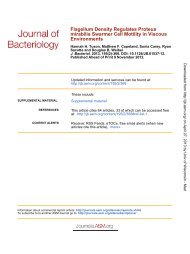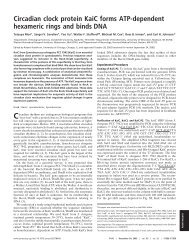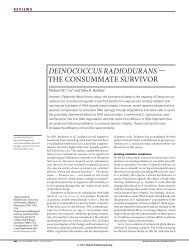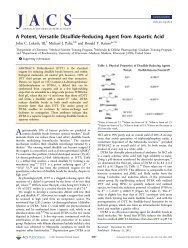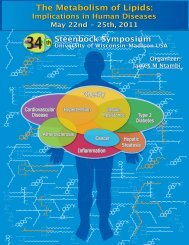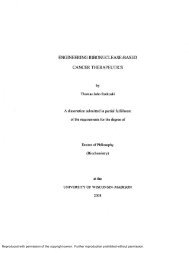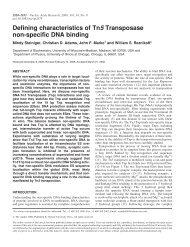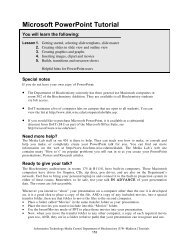Concerted and Stepwise Dehydration Mechanisms Observed in ...
Concerted and Stepwise Dehydration Mechanisms Observed in ...
Concerted and Stepwise Dehydration Mechanisms Observed in ...
You also want an ePaper? Increase the reach of your titles
YUMPU automatically turns print PDFs into web optimized ePapers that Google loves.
<strong>Concerted</strong> <strong>and</strong> <strong>Stepwise</strong> <strong>Dehydration</strong> <strong>Mechanisms</strong> <strong>Observed</strong> <strong>in</strong> Wild-Type <strong>and</strong><br />
Mutated Escherichia coli dTDP-Glucose 4,6-Dehydratase †<br />
Adrian D. Hegeman, ‡ Jeffrey W. Gross, ‡ <strong>and</strong> Perry A. Frey*<br />
Department of Biochemistry, UniVersity of Wiscons<strong>in</strong>-Madison, Madison, Wiscons<strong>in</strong> 53705<br />
ReceiVed August 31, 2001; ReVised Manuscript ReceiVed January 2, 2002<br />
ABSTRACT: The conversion of dTDP-glucose <strong>in</strong>to dTDP-4-keto-6-deoxyglucose by Escherichia coli dTDPglucose<br />
4,6-dehydratase (4,6-dehydratase) takes place <strong>in</strong> the active site <strong>in</strong> three steps: dehydrogenation<br />
to dTDP-4-ketoglucose, dehydration to dTDP-4-ketoglucose-5,6-ene, <strong>and</strong> rereduction of C6 to the methyl<br />
group. The 4,6-dehydratase makes use of tightly bound NAD + as the coenzyme for transiently oxidiz<strong>in</strong>g<br />
the substrate, activat<strong>in</strong>g it for the dehydration step. <strong>Dehydration</strong> may occur by either of two mechanisms,<br />
enolization of the dTDP-4-ketoglucose <strong>in</strong>termediate, followed by elim<strong>in</strong>ation [as proposed for -elim<strong>in</strong>ations<br />
by Gerlt, J. A., <strong>and</strong> Gassman, P. G. (1992) J. Am. Chem. Soc. 114, 5928-5934], or a concerted 5,6elim<strong>in</strong>ation<br />
of water from the <strong>in</strong>termediate. To assign one of these two mechanisms, a simultaneous k<strong>in</strong>etic<br />
characterization of glucosyl C5( 1 H/ 2 H) solvent hydrogen <strong>and</strong> C6( 16 OH/ 18 OH) solvent oxygen exchange<br />
was performed us<strong>in</strong>g matrix-assisted laser desorption/ionization time-of-flight mass spectrometry. The<br />
reaction of the wild-type enzyme is shown to proceed through a concerted dehydration mechanism.<br />
Interest<strong>in</strong>gly, mutation of Asp135, the acid catalyst, to Asn or Ala alters the mechanism, allow<strong>in</strong>g enolization<br />
to occur to vary<strong>in</strong>g extents. While aspartic acid 135 is the acid catalyst for dehydration <strong>in</strong> the wild-type<br />
enzyme, the differential enolization capabilities of D135N <strong>and</strong> D135A dehydratases suggest an additional<br />
role for this residue. We postulate that the switch from a concerted to stepwise dehydration mechanism<br />
observed <strong>in</strong> the aspartic acid variants is due to the loss of control over the glucosyl C5-C6 bond rotation<br />
<strong>in</strong> the active site.<br />
dTDP-glucose 4,6-dehydratase 1,2 catalyzes the conversion<br />
of dTDP-glucose <strong>in</strong>to dTDP-4-keto-6-deoxyglucose. The<br />
homodimeric Escherichia coli 4,6-dehydratase (RffG) conta<strong>in</strong>s<br />
one irreversibly bound NAD + per subunit <strong>and</strong> catalyzes<br />
a net redox neutral reaction through a mechanism that<br />
<strong>in</strong>cludes four chemically dist<strong>in</strong>ct species (Scheme 1). The<br />
first step, 4-dehydrogenation of substrate, is a critical<br />
activat<strong>in</strong>g step for -elim<strong>in</strong>ation of water between C5 <strong>and</strong><br />
C6. In the absence of activation by the adjacent ketone group,<br />
deprotonation at C5 (pKa > 40) would be impossible under<br />
any conceivable conditions <strong>in</strong> an enzymatic active site. While<br />
the 4-keto functionality acidifies the C5 proton, br<strong>in</strong>g<strong>in</strong>g its<br />
pKa <strong>in</strong>to the range of 18-19 (1), it also creates additional<br />
possibilities for the catalytic mechanism of dehydration. In<br />
particular, water elim<strong>in</strong>ation might proceed more quickly by<br />
enolization to an enol (or enolate) <strong>in</strong>termediate, as depicted<br />
<strong>in</strong> Scheme 2, than by concerted elim<strong>in</strong>ation. In Schemes 1<br />
<strong>and</strong> 2 NAD + , NADH, <strong>and</strong> all dTDP sugars rema<strong>in</strong> bound to<br />
the active site throughout the course of a s<strong>in</strong>gle turnover.<br />
† This work was supported by Grants GM30480 (P.A.F.) <strong>and</strong><br />
GM20552 (J.W.G.) from the National Institute of General Medical<br />
Sciences.<br />
* Correspond<strong>in</strong>g author. Tel: (608) 262-0055. Fax: (608) 265-2904.<br />
E-mail: frey@biochem.wisc.edu.<br />
‡ Both authors have contributed equally to this work.<br />
1 Abbreviations: BSA, bov<strong>in</strong>e serum album<strong>in</strong>; 4,6-dehydratase,<br />
dTDP-glucose 4,6-dehydratase; dTDP-glucose, thymid<strong>in</strong>e 5′-diphospho-<br />
R-D-glucose; dTDP-glucose-d7, dTDP-[1,2,3,4,5,6,6- 2 H7]glucose; DTT,<br />
dithiothreitol; MALDI-TOF MS, matrix-assisted laser desorption/<br />
ionization time-of-flight mass spectrometry; NAD + , nicot<strong>in</strong>amide<br />
aden<strong>in</strong>e d<strong>in</strong>ucleotide (oxidized); NADH, nicot<strong>in</strong>amide aden<strong>in</strong>e d<strong>in</strong>ucleotide<br />
(reduced); Tris, tris(hydroxymethyl)am<strong>in</strong>omethane; wt, wild type.<br />
2 dTDP R-D-glucose 4,6-hydro-lyase, EC 4.2.1.46.<br />
Biochemistry 2002, 41, 2797-2804<br />
Scheme 1<br />
2797<br />
In enzyme-catalyzed R- elim<strong>in</strong>ation reactions where<br />
activation by the carbonyl functionality may not be sufficient,<br />
enol formation with concerted R-proton abstraction <strong>and</strong><br />
stabilization of the enolate has been proposed to expla<strong>in</strong> the<br />
observed rate enhancements (2). Certa<strong>in</strong>ly such a mechanism<br />
presents additional opportunities for enzymatic catalysis, such<br />
as protonation of the enolate oxygen, or electrostatic catalysis<br />
of the enolate formation. <strong>Mechanisms</strong> for the 4,6-dehydratase<br />
that <strong>in</strong>clude an enol/enolate have appeared consistently <strong>in</strong><br />
the literature, the earliest by Gabriel <strong>and</strong> L<strong>in</strong>dquist (3) <strong>and</strong><br />
the most recent by Allard <strong>and</strong> co-workers (4).<br />
A recent study has shown that the 4,6-dehydratase active<br />
site conta<strong>in</strong>s a base, Glu136, <strong>and</strong> an acid, Asp135, that<br />
10.1021/bi011748c CCC: $22.00 © 2002 American Chemical Society<br />
Published on Web 01/31/2002
2798 Biochemistry, Vol. 41, No. 8, 2002 Hegeman et al.<br />
Scheme 2<br />
catalyze dehydration (5). While the elim<strong>in</strong>ation of water has<br />
been shown to proceed with syn stereochemistry with respect<br />
to the C5(H) <strong>and</strong> C6(OH) (6), no <strong>in</strong>formation has been<br />
published that would help to dist<strong>in</strong>guish between the<br />
concerted <strong>and</strong> stepwise mechanisms for dehydration outl<strong>in</strong>ed<br />
<strong>in</strong> Schemes 1 <strong>and</strong> 2. It is important for the precise<br />
underst<strong>and</strong><strong>in</strong>g of the function of 4,6-dehydratase that the<br />
mechanistic relevance of enolization be determ<strong>in</strong>ed.<br />
Dur<strong>in</strong>g the 4,6-dehydratase-catalyzed conversion of substrate<br />
to product, there is complete exchange of the C5(H)<br />
with solvent hydrogen (3, 7). To accomplish this, Glu136<br />
must exchange rapidly with solvent prior to the reprotonation<br />
of C5, which occurs <strong>in</strong> the reduction of the dTDP-4-ketoglucose-5,6-ene<br />
by NADH (Scheme 1). This C5(H/D)<br />
exchange has also been observed <strong>in</strong> the absence of net<br />
catalysis. In our recent pre-steady-state analysis of wt 4,6dehydratase<br />
(8), us<strong>in</strong>g dTDP-glucose-d7 as the substrate, we<br />
observed the transient formation of C5-exchanged substrate<br />
(dTDP-glucose-d6). It became apparent that C5(H/D) <strong>and</strong> C6-<br />
( 16OH/ 18OH) substrate exchange reactions could be used as<br />
tools to detect the <strong>in</strong>volvement of an enolate <strong>in</strong>termediate<br />
<strong>in</strong> the chemistry of water elim<strong>in</strong>ation. If water elim<strong>in</strong>ation<br />
occurs <strong>in</strong> concert with C5(H) abstraction, then the rates of<br />
deuterium exchange at C5 <strong>and</strong> [ 18O]water exchange at C6<br />
should be identical. However, if an enol/enolate <strong>in</strong>termediate<br />
forms to any significant extent prior to water elim<strong>in</strong>ation,<br />
one would expect the rate of solvent hydrogen exchange from<br />
C5 to exceed the [ 18O]water exchange from C6. In this study<br />
we present the k<strong>in</strong>etic analysis of C5 solvent hydrogen (D/<br />
H) <strong>and</strong> C6( 16OH/ 18OH) solvent oxygen exchange <strong>in</strong>to<br />
substrate catalyzed by wt 4,6-dehydratase <strong>and</strong> two Asp135<br />
variants (D135N <strong>and</strong> D135A dehydratases). In addition to<br />
be<strong>in</strong>g the acid catalyst for dehydration, active site residue<br />
Asp135 has been found to be an important controll<strong>in</strong>g<br />
determ<strong>in</strong>ant for enolization.<br />
EXPERIMENTAL PROCEDURES<br />
Methods <strong>and</strong> Materials. wt, D135N, <strong>and</strong> D135A 4,6dehydratases<br />
were prepared us<strong>in</strong>g the aff<strong>in</strong>ity purification<br />
system <strong>and</strong> procedure outl<strong>in</strong>ed previously (9). Synthesis <strong>and</strong><br />
purification of dTDP-R-D-glucose-d7 <strong>and</strong> analysis of samples<br />
by MALDI-TOF MS were performed as described previously<br />
(8). Mass spectra were collected on a PE-Biosystems<br />
Voyager-DE MALDI-TOF mass spectrometer, equipped with<br />
delayed extraction, <strong>in</strong> negative reflectron mode. Enzyme <strong>and</strong><br />
nucleotide sugar concentrations were determ<strong>in</strong>ed us<strong>in</strong>g UV/<br />
visible measurements with a Shimadzu UV-1601PC dual<br />
beam spectrophotometer <strong>and</strong> the ext<strong>in</strong>ction coefficients<br />
81000 M -1 cm -1 for enzyme <strong>and</strong> 10200 M -1 cm -1 for<br />
thymid<strong>in</strong>e nucleotides, both at pH 7.0 <strong>and</strong> 20 °C.<br />
[ 18O]Water. A 1 mL sample of [ 18O]water (∼80% enriched<br />
<strong>and</strong> conta<strong>in</strong><strong>in</strong>g HCl) was generously provided by W. W.<br />
Clel<strong>and</strong>. The HCl was removed first by add<strong>in</strong>g dry Tris base<br />
until the solution was weakly alkal<strong>in</strong>e <strong>and</strong> then by perform<strong>in</strong>g<br />
a two-bulb distillation. To determ<strong>in</strong>e the ratio of 16Oto18O, approximately 0.5 mg of PCl5 was quenched <strong>in</strong> 40 µL of<br />
the 18O-enriched water. The result<strong>in</strong>g HCl was neutralized<br />
with an excess of solid imidazole, <strong>and</strong> the 31P NMR spectrum<br />
was obta<strong>in</strong>ed <strong>in</strong> 500 µL ofD2O. The relative abundance of<br />
16 18 O <strong>and</strong> O <strong>in</strong> phosphate was determ<strong>in</strong>ed by <strong>in</strong>tegrat<strong>in</strong>g the<br />
five peaks of the phosphate signal [centered at 2.1 ppm; 0.021<br />
ppm separation (10); the peaks, from downfield to upfield,<br />
correspond to 0-4 atoms of 18O <strong>in</strong> phosphate] with the<br />
program Peakfit (SPSS Inc.). The percentage enrichment of<br />
18O was found to be 78%.<br />
Exchange Reactions. Three 100 µL reaction mixtures were<br />
assembled, each conta<strong>in</strong><strong>in</strong>g 1 mM dTDP-glucose-d7, 1mM<br />
DTT, 1 mg/mL BSA (fraction V), 10 mM ammonium<br />
acetate, [ 18O]water, <strong>and</strong> 1.8, 24.7, or 14.7 µM wt, D135A,<br />
or D135N 4,6-dehydratase, respectively. All of the reagents<br />
(except for the [ 18O]water) were carefully adjusted to pH<br />
7.5 prior to mix<strong>in</strong>g. Each tube conta<strong>in</strong>ed m<strong>in</strong>imal amounts<br />
of components dissolved <strong>in</strong> natural abundance H2O that<br />
contribute to the ultimate isotopic dilution of 18O. The f<strong>in</strong>al<br />
percentage of [ 18O]water <strong>in</strong> the wt, D135A, <strong>and</strong> D135N<br />
reaction mixtures was 72% <strong>in</strong> each case. Reactions were<br />
<strong>in</strong>itiated at 18 °C by addition of enzyme. For analysis,<br />
MALDI-TOF MS samples were prepared by quench<strong>in</strong>g 10<br />
µL aliquots of each reaction, at various times, <strong>in</strong> 100 µL of<br />
70 °C ethanol (8). Precipitated prote<strong>in</strong> was removed by<br />
centrifugation, <strong>and</strong> the ethanolic supernatant was concentrated<br />
to dryness <strong>in</strong> a speed-vac concentrator (Savant) at room<br />
temperature. The dried residue was dissolved <strong>in</strong> 6 µLofH2O<br />
<strong>and</strong> subjected to MALDI-TOF mass spectrometric analysis.<br />
Data Process<strong>in</strong>g. Mass spectral peak areas were obta<strong>in</strong>ed<br />
us<strong>in</strong>g the program Peakfit (SPSS). The substrate dTDPglucose-d7<br />
(monoisotopic mass 571.2, detected <strong>in</strong> the negative<br />
ion mode [M - H] at 570.2) displayed an isotopic<br />
envelope consist<strong>in</strong>g of four peaks with 2.3% of the area at<br />
m/z ) 569.2, 72.1% at m/z ) 570.2, 17.8% at m/z ) 571.2,<br />
<strong>and</strong> 7.8% at m/z ) 572.2 (errors are ∼(0.1%). The 569.2<br />
peak was present because the glucose-d7 used <strong>in</strong> the synthesis<br />
of dTDP-glucose-d7 conta<strong>in</strong>ed only 98% deuterium enrichment;<br />
the 571.2 <strong>and</strong> 572.2 peaks were due to the natural<br />
abundance of 13C throughout the molecule. Identical isotopic<br />
envelopes are assumed for the C5(D) <strong>and</strong> C6( 18OH) exchanged<br />
dTDP-glucose species. The relative amounts of each<br />
of the four possible exchanged substrate species (dTDP-[6-<br />
16O]glucose-d7, dTDP-[6-18O]glucose-d7, dTDP-[6-16O]glu-
4,6-Dehydratase Biochemistry, Vol. 41, No. 8, 2002 2799<br />
FIGURE 1: Representative mass spectral data for time courses of exchange. Data are exchange reactions catalyzed by wt, D135N, <strong>and</strong><br />
D135A 4,6-dehydratases. Raw MALDI-TOF mass spectra of timed <strong>and</strong> quenched samples from exchange reactions with wt, D135N, <strong>and</strong><br />
D135A are displayed with the time coord<strong>in</strong>ate listed to the right of each spectrum. The mass range (m/z ) 569-572) shows all of the<br />
various isotopically exchanged forms of dTDP-glucose present <strong>in</strong> these reactions. The formation of dTDP-4-keto-6-deoxyglucose-d6 (the<br />
only form of product generated <strong>in</strong> these reactions) was monitored at m/z ) 551 <strong>and</strong> is not shown <strong>in</strong> these spectra. The time zero spectrum<br />
is shown with the D135N reaction <strong>and</strong> is identical for all three reactions (this gives the isotopic envelope for the dTDP-glucose-d7 start<strong>in</strong>g<br />
material). Spectral data are corrected <strong>in</strong> two ways to give the subsequent progress curves. First, the overlapp<strong>in</strong>g isotopic envelopes are<br />
deconvoluted to yield the quantity of each isotopically exchanged form of substrate. Second, the quantities of dTDP-glucose-d6-C6 16 O <strong>and</strong><br />
dTDP-glucose-d6-C6 18 O are adjusted to correct for only 72% 18 O solvent enrichment <strong>in</strong> each reaction. Both corrections are detailed <strong>in</strong><br />
Experimental Procedures. The species at m/z 569 accumulat<strong>in</strong>g with time <strong>in</strong> the wt <strong>and</strong> D135N reactions is due to the presence of 28% 16 O<br />
<strong>in</strong> the [ 18 O]H2O <strong>and</strong> appears at the expense of the species at m/z 571. In the wt reaction, correction for 16 O<strong>in</strong>[ 18 O]H2O, as described <strong>in</strong><br />
Experimental Procedures, elim<strong>in</strong>ates this species. In the reaction of D135A the m/z 569 species arises ma<strong>in</strong>ly from faster exchange of the<br />
C5(D) than the C6(OH) ow<strong>in</strong>g to the stepwise mechanism followed by the mutated enzyme.<br />
cose-d6, <strong>and</strong> dTDP-[6- 18 O]glucose-d6) were obta<strong>in</strong>ed from<br />
the solution to the system of four algebraic expressions:<br />
(1) area of 569.2 peak ) 72.1% (dTDP-<br />
[6- 16 O]glucose-d6 ) + 2.3% (dTDP-[6- 16 O]glucose-d7 )<br />
(2) area of 570.2 peak ) 17.8% (dTDP-<br />
[6- 16 O]glucose-d6 ) + 72.1% (dTDP-<br />
[6- 16 O]glucose-d7 ) + 2.3% (dTDP-[6- 18 O]glucose-d6 )<br />
(3) area of 571.2 peak ) 7.8% (dTDP-<br />
[6- 16 O]glucose-d6 ) + 17.8% (dTDP-<br />
[6- 16 O]glucose-d7 ) + 72.1% (dTDP-<br />
[6- 18 O]glucose-d6 ) + 2.3% (dTDP-[6- 18 O]glucose-d7 )<br />
(4) area of 572.2 peak ) 7.8% (dTDP-<br />
[6- 16 O]glucose-d7 ) + 17.8% (dTDP-<br />
[6- 18 O]glucose-d6 ) + 72.1% (dTDP-[6- 18 O]glucose-d7 )<br />
As little or no signal was detectable at m/z ) 568.2, 573.2,<br />
574.2, <strong>and</strong> 575.2 expressions were not derived for these<br />
masses. The concentration of each species <strong>in</strong> a given sample<br />
was then calculated us<strong>in</strong>g the total areas for the isotopic<br />
envelope of product (major peak at m/z ) 551.2) <strong>and</strong><br />
deconvoluted substrate species normalized to the start<strong>in</strong>g<br />
concentration of 1 mM. Assum<strong>in</strong>g an <strong>in</strong>significant 18 O<br />
isotope effect for the C6(OH) exchange reaction, it is possible<br />
to correct for partial solvent 18 O enrichment. To make this<br />
correction, the [dTDP-[6- 18 O]glucose-d6] was divided by the<br />
fraction of 18 O <strong>in</strong> each reaction (0.72 <strong>in</strong> each case as<br />
measured above), <strong>and</strong> the <strong>in</strong>crease was subtracted from the<br />
experimentally observed [dTDP-[6- 16 O]glucose-d6].<br />
RESULTS<br />
The rates of glucosyl C5(D) solvent hydrogen <strong>and</strong> C6-<br />
(OH) solvent oxygen exchange <strong>in</strong>to the substrate were<br />
simultaneously determ<strong>in</strong>ed by mass spectrometric characterization<br />
dur<strong>in</strong>g the multiple turnover conversion of dTDPglucose-d7<br />
to product by wt, D135N, <strong>and</strong> D135A 4,6dehydratase,<br />
<strong>in</strong> 18 O-enriched water. Representative mass<br />
spectra, show<strong>in</strong>g the complete set of substrate peaks for wt<br />
<strong>and</strong> D135A reactions, are presented <strong>in</strong> Figure 1. It is obvious<br />
from these raw data that different exchange properties are<br />
manifested <strong>in</strong> the reactions of wt <strong>and</strong> D135A dehydratases.<br />
The relative abundance of substrate <strong>and</strong> product molecules
2800 Biochemistry, Vol. 41, No. 8, 2002 Hegeman et al.<br />
FIGURE 2: Progress curves for exchange of substrate C5(D) <strong>and</strong><br />
C6(OH) by wt, D135N, <strong>and</strong> D135A 4,6-dehydratase. The concentrations<br />
of dTDP-glucose-d7-C6 16 O(0), dTDP-glucose-d6-C6 16 O<br />
([), dTDP-glucose-d6-C6 18 O(b), <strong>and</strong> dTDP-4-keto-6-deoxyglucose-d6<br />
(4) are plotted at various times for wt, D135N, <strong>and</strong> D135A<br />
exchange reactions. dTDP-glucose-d7-C6 18 O did not accumulate <strong>in</strong><br />
any of the reactions. Curves for each species <strong>in</strong> each reaction were<br />
derived as data were fitted to a m<strong>in</strong>imal k<strong>in</strong>etic mechanism us<strong>in</strong>g<br />
the program Dynafit (11).<br />
was determ<strong>in</strong>ed by <strong>in</strong>tegration of the MS data, deconvolution<br />
of overlapp<strong>in</strong>g isotopic envelopes, <strong>and</strong> correction for fractional<br />
18 O enrichment, as described <strong>in</strong> Experimental Procedures.<br />
The result<strong>in</strong>g data were plotted <strong>in</strong> Figure 2 for all<br />
three reactions. These time courses show the depletion of<br />
dTDP-glucose-d7, production of dTDP-4-keto-6-deoxyglucose-d6,<br />
<strong>and</strong> the transient formation of dTDP-[6- 18 O]glucosed6.<br />
As expected, none of the reactions showed accumulation<br />
of dTDP-[6- 18 O]glucose-d7, which would only form if<br />
elim<strong>in</strong>ation occurred by way of a primary carbocation<br />
<strong>in</strong>termediate. Biological elim<strong>in</strong>ation reactions usually occur<br />
by E1cb or concerted (E2-like) mechanisms <strong>and</strong> not by E1<br />
mechanisms. Biological reactions with carbocationic <strong>in</strong>termediates<br />
are not observed, except <strong>in</strong> cases of allylic<br />
stabilization of the carbocation, as <strong>in</strong> polyterpene cyclases,<br />
<strong>and</strong> glycosyl transfer reactions through oxocarbenium ion<br />
<strong>in</strong>termediates.<br />
The major qualitative difference among the three progress<br />
curves <strong>in</strong> Figure 2 is the rate of formation <strong>and</strong> accumulation<br />
of substrate with the C5 solvent hydrogen exchanged that<br />
has not also acquired 18 O, that is, dTDP-[6- 16 O]glucose-d6.<br />
The reaction of wt dehydratase shows no accumulation of<br />
dTDP-[6- 16 O]glucose-d6, only the transient accumulation of<br />
doubly exchanged substrate (dTDP-[6- 18 O]glucose-d6). In<br />
contrast, the reaction of D135A dehydratase shows a rapid<br />
burst of C5 solvent hydrogen exchanged substrate (dTDP-<br />
[6- 16 O]glucose-d6) preced<strong>in</strong>g the slower transient formation<br />
of doubly exchanged substrate (dTDP-[6- 18 O]glucose-d6).<br />
Unlike the wt enzyme, the D135N dehydratase allows some<br />
s<strong>in</strong>gly exchanged substrate to accumulate but does not show<br />
the same rapid burst of proton exchange catalyzed by D135A.<br />
To enable quantitative <strong>in</strong>terpretation of our exchange<br />
results, all three sets of progress curves were fitted to a<br />
comprehensive m<strong>in</strong>imal k<strong>in</strong>etic model shown <strong>in</strong> Figure 3.<br />
In this model dTDP-glucose-d7 may be depleted through one<br />
or both of two irreversible steps. The first (k1) leads directly<br />
to C5 solvent hydrogen exchanged substrate (dTDP-[6- 16 O]glucose-d6)<br />
<strong>and</strong> requires dehydrogenation to the 4-ketone,<br />
5-enolization, enzyme-base solvent hydrogen exchange, <strong>and</strong><br />
re-formation of substrate. The second (k3) leads to a common<br />
<strong>in</strong>termediate, I, which must be the dTDP-4-ketoglucose-5,6ene<br />
as it lacks both the C5(H) <strong>and</strong> the C6(OH) but is capable<br />
of react<strong>in</strong>g with water <strong>in</strong> the active site <strong>in</strong> revert<strong>in</strong>g to the<br />
substrate. Because the reaction was carried out <strong>in</strong> [ 18 O]water,<br />
re-formation of substrate from I can only generate dTDP-<br />
[6- 18 O]glucose-d6. This process was modeled as a reversible<br />
step (k5, k6). The re<strong>in</strong>corporation of 16 O <strong>in</strong>to I, yield<strong>in</strong>g the<br />
other two substrate forms (dTDP-[6- 16 O]glucose-d7 <strong>and</strong><br />
dTDP-[6- 16 O]glucose-d6), is disallowed because of isotopic<br />
dilution of 16 O. These steps were modeled as irreversible<br />
(k3, k5). The same rate constant (k5) was used for the forward<br />
reaction of both C5 protonated substrates, as experimental<br />
error will be of the same or larger magnitude as the 18 O<br />
isotope effect. Transformation of I <strong>in</strong>to product was modeled<br />
with an irreversible step (k7).<br />
At first glance, analysis of the reaction might appear to<br />
be subject to simplification by steady-state approximations.<br />
Because substrate is <strong>in</strong> excess of enzyme (1 mM dTDP-[6-<br />
16 O]glucose-d7; wt, D135A, <strong>and</strong> D135N are 1.8-24.7 µM)<br />
<strong>and</strong> the isotopically exchanged forms of substrate (dTDP-<br />
[6- 16 O]glucose-d6 <strong>and</strong> dTDP-[6- 18 O]glucose-d6) are diluted<br />
<strong>in</strong>to a large pool of dTDP-[6- 16 O]glucose-d7, the reaction<br />
can only be accurately described us<strong>in</strong>g a series of differential<br />
equations. As the reaction progresses, the product <strong>and</strong><br />
substrate will compete for the enzyme. For these reasons<br />
substrate <strong>and</strong> product b<strong>in</strong>d<strong>in</strong>g steps (kon, koff) were <strong>in</strong>cluded<br />
<strong>in</strong> the differential k<strong>in</strong>etic model. Although KD for the<br />
substrate has not been determ<strong>in</strong>ed, its value can be estimated<br />
from other constants. The KM is 5 µM (9). The substrate<br />
analogue dTDP-xylose b<strong>in</strong>ds wt 4,6-dehydratase with a KD<br />
of 7 µM, <strong>and</strong> the product b<strong>in</strong>ds with a KD of 25 µM (5). For<br />
the purposes of model<strong>in</strong>g the exchange reactions the value<br />
of KD for the substrate was assumed to be 10 µM. Equilibrium<br />
b<strong>in</strong>d<strong>in</strong>g was also assumed with kon be<strong>in</strong>g fixed at
4,6-Dehydratase Biochemistry, Vol. 41, No. 8, 2002 2801<br />
FIGURE 3: K<strong>in</strong>etic mechanism for the action of 4,6-dehydratase. This is the m<strong>in</strong>imal k<strong>in</strong>etic mechanism used to fit all three data sets shown<br />
<strong>in</strong> Figure 2. Steps <strong>in</strong>dicated by k1, k3, <strong>and</strong> k5 are irreversible because of <strong>in</strong>f<strong>in</strong>ite dilution of exchanged DH 16 O <strong>and</strong> H2 16 O <strong>in</strong>to solvent H2 18 O.<br />
Listed m/z values are for the monoanionic (M - H) nucleotide sugar species as detected dur<strong>in</strong>g negative ion mode MALDI-TOF mass<br />
spectrometric analysis. Intermediate I is <strong>in</strong>cluded <strong>in</strong> this model to provide appropriate connectivity between detectable nucleotide sugar<br />
species. From previous studies (8), I will predom<strong>in</strong>antly be dTDP-4-ketoglucose-5,6-ene, but s<strong>in</strong>ce enzyme concentrations are very low<br />
compared to dTDP-glucose, I is undetectable.<br />
1000000 M -1 s -1 (approximately kcat/KM ) 820000 M -1 s -1 ;<br />
9) <strong>and</strong> koff at 10 s -1 (consistent with KD ∼10 µM). B<strong>in</strong>d<strong>in</strong>g<br />
isotope effects were assumed to be <strong>in</strong>significant for the<br />
present purposes, <strong>and</strong> identical kon <strong>and</strong> koff values were used<br />
for all three substrate species. Values for kon <strong>and</strong> koff were<br />
1000000 M -1 s -1 <strong>and</strong> 10 s -1 for wt <strong>and</strong> 100000 M -1 s -1<br />
<strong>and</strong>1s -1 for D135N <strong>and</strong> D135A. The fitt<strong>in</strong>g program,<br />
Dynafit (11), did not converge with slower kon <strong>and</strong> koff for<br />
wt or faster kon <strong>and</strong> koff for the reaction of D135N. The data<br />
for D135A were fitted with either set of kon <strong>and</strong> koff values<br />
with negligible effects on the fitted parameters. The progress<br />
curve fits are shown as solid <strong>and</strong> dashed l<strong>in</strong>es <strong>in</strong> Figure 4,<br />
<strong>and</strong> the k<strong>in</strong>etic parameters derived from these fits are listed<br />
<strong>in</strong> Table 1.<br />
The failure of dTDP-glucose-d6-C6 16 O to accumulate <strong>in</strong><br />
the wt progress curves makes it impossible to derive a value<br />
for k1, <strong>in</strong>dicat<strong>in</strong>g that k1 , k3. The large differences <strong>in</strong> rate<br />
constants between wt <strong>and</strong> the Asp135 variants are not<br />
apparent <strong>in</strong> Figure 2 because of differences <strong>in</strong> enzyme<br />
concentration <strong>and</strong> time doma<strong>in</strong>s. In each case the major<br />
contributor to overall rate limitation <strong>in</strong> product formation is<br />
k7. The published decrements <strong>in</strong> kcat for D135N <strong>and</strong> D135A<br />
compared with wt kcat (124- <strong>and</strong> 223-fold, respectively) are<br />
consistent with the 50- <strong>and</strong> 107-fold decreases observed for<br />
k7, requir<strong>in</strong>g only an additional 2-fold contribution from other<br />
steps. All of the other constants <strong>in</strong> the Asp135 variant<br />
reactions have suffered major decrements, the largest be<strong>in</strong>g<br />
for k3 <strong>in</strong> the reaction of D135A, which is nearly 5000-fold<br />
below the wt value. The value of k3 for D135N dehydratase<br />
is only 400-fold below the wt value.<br />
FIGURE 4: Effects of C5-C6 bond rotomeric configuration on<br />
chemistry. Newman projections through the C5-C6 bond show<br />
the importance of rotomeric conformation to elim<strong>in</strong>ation chemistry.<br />
In panel A, the configuration is optimal for the concerted syn<br />
elim<strong>in</strong>ation. In panel B, elim<strong>in</strong>ation cannot occur as a result of<br />
<strong>in</strong>sufficient orbital overlap; deprotonation of C5 results <strong>in</strong> delocalization<br />
of the nascent carbanion <strong>in</strong>to the adjacent ketone<br />
functionality (enolization).<br />
Both water elim<strong>in</strong>ation <strong>and</strong> enolization are <strong>in</strong>itiated by<br />
C5H/D abstraction. To judge the extent of the effects of the<br />
mutation of Asp135 on dehydration, it is valuable to compare<br />
the sum of the rate constants for enolization (k1) <strong>and</strong><br />
concerted elim<strong>in</strong>ation (k3) to the wt k3. Quite remarkably, k1<br />
+ k3 (listed <strong>in</strong> Table 1) values are very similar for the D135A<br />
<strong>and</strong> D135N dehydratases <strong>and</strong> are 370-fold lower than k3 for
2802 Biochemistry, Vol. 41, No. 8, 2002 Hegeman et al.<br />
Table 1: K<strong>in</strong>etic Parameters Derived from Steady-State Exchange<br />
Progress Curves a<br />
wt dehydratase. Obviously the 360-fold decrease may not<br />
fully reflect the extent of the drop <strong>in</strong> rate of water elim<strong>in</strong>ation,<br />
as k3 refers to the net forward rate through the fully reversible<br />
4-dehydrogenation <strong>and</strong> the irreversible [ 16 O]water elim<strong>in</strong>ation.<br />
The ratio of k1 <strong>and</strong> k1 + k3 (values listed <strong>in</strong> Table 1)<br />
describes the partition<strong>in</strong>g between enolization <strong>and</strong> concerted<br />
elim<strong>in</strong>ation. This coefficient <strong>in</strong>dicates the fraction of dTDP-<br />
[6- 16 O]glucose-d7 that is depleted by enolization. For D135A,<br />
D135N, <strong>and</strong> wt 4,6-dehydratase these values are 0.9, 0.07,<br />
<strong>and</strong> 0.0, respectively. The large differences <strong>in</strong> these fractions<br />
from D135N to D135A despite similar values of k1 + k3<br />
clearly <strong>in</strong>dicate that the <strong>in</strong>creased occurrence of enolization<br />
is not simply due to removal of acid catalysis but must have<br />
a more fundamental mechanistic basis. This issue will be<br />
dealt with extensively below.<br />
DISCUSSION<br />
wt rate (s -1 ) D135A rate (s -1 ) D135N rate (s -1 )<br />
k1 - b 0.0053 ((0.0006) 0.0004 ((0.0001)<br />
k3 2.1 ((0.8) 0.0004 ((0.0002) 0.005 ((0.0008)<br />
k5 1.5 ((0.7) 0.0022 ((0.0003) 0.004 ((0.0009)<br />
k6 0.13 ((0.01) 0.0008 ((0.0003) 0.001 ((0.0003)<br />
k7 0.15 ((0.01) 0.0014 ((0.0004) 0.003 ((0.0005)<br />
k1 + k3 c 2.1 ((0.8) 0.0057 ((0.0008) 0.0054 ((0.0009)<br />
k1/(k1 + k3) d 0.0 0.9 ((0.2) 0.07 ((0.02)<br />
a Rate constants were obta<strong>in</strong>ed us<strong>in</strong>g the k<strong>in</strong>etic mechanism shown<br />
<strong>in</strong> Figure 3 <strong>and</strong> the fitt<strong>in</strong>g program Dynafit (11). b The rate constant k1<br />
<strong>in</strong> wt consistently approached a mean<strong>in</strong>glessly small number with a<br />
large error as the other rate constants converged. This step could be<br />
removed from the k<strong>in</strong>etic mechanism used to fit the wt data without<br />
affect<strong>in</strong>g the values of the other constants. c This expression corresponds<br />
to the rate of dTDP-glucose-d7 depletion. d This ratio is the fraction of<br />
dTDP-glucose-d7 that enolizes rather than elim<strong>in</strong>at<strong>in</strong>g water.<br />
The primary objective of this study is to determ<strong>in</strong>e whether<br />
wt 4,6-dehydratase catalyzes the dehydration of dTDP-4ketoglucose<br />
to dTDP-4-ketoglucose-5,6-ene through a stepwise<br />
(Scheme 2), or concerted (Scheme 1), elim<strong>in</strong>ation of<br />
water. By simultaneous k<strong>in</strong>etic analysis of C5(D) solvent<br />
hydrogen <strong>and</strong> C6(OH) solvent oxygen exchange <strong>in</strong>to substrate,<br />
dehydration appears to proceed through the concerted<br />
elim<strong>in</strong>ation mechanism. Interest<strong>in</strong>gly, variants of active site<br />
am<strong>in</strong>o acid residue Asp135 alter the dehydration mechanism<br />
so that elim<strong>in</strong>ation occurs through the stepwise mechanism.<br />
The D135N <strong>and</strong> D135A dehydratases display dist<strong>in</strong>ctly<br />
different partition<strong>in</strong>g between concerted elim<strong>in</strong>ation <strong>and</strong><br />
stepwise elim<strong>in</strong>ation pathways, albeit at much slower rates,<br />
allow<strong>in</strong>g sensible speculation on the physical basis for the<br />
control of this partition<strong>in</strong>g (below).<br />
Clearly our mechanistic <strong>in</strong>terpretations of concurrent<br />
exchange of C5(D) <strong>and</strong> C6(OH) rely on the exchange of<br />
protons <strong>and</strong> the release of water molecules from the enzyme<br />
active site at rates exceed<strong>in</strong>g that of elim<strong>in</strong>ation chemistry.<br />
The direct observation of concerted <strong>and</strong> stepwise mechanisms<br />
<strong>in</strong> wt <strong>and</strong> variant dehydratases, respectively, demonstrates<br />
the rapidity with which protons <strong>and</strong> oxygen exchange with<br />
solvent, at least with<strong>in</strong> the context of the slower reactions<br />
of Asp135 variants. For the much faster wt-catalyzed<br />
exchange reaction, we know that <strong>in</strong> the overall reaction the<br />
C5(H) exchanges much faster than turnover kcat (5 s -1 )<br />
because of the 100% <strong>in</strong>corporation of deuterium at C5 <strong>in</strong><br />
the product generated <strong>in</strong> D2O (3, 7). While one might be<br />
concerned that the elim<strong>in</strong>ated water molecule could be<br />
reta<strong>in</strong>ed <strong>in</strong> the wt active site, the absence of accumulat<strong>in</strong>g<br />
dTDP-[6- 16 O]glucose-d6 <strong>in</strong> the wt profile shows that water<br />
is readily released from the active site.<br />
The essential facts about the k<strong>in</strong>etics of the elim<strong>in</strong>ation<br />
reaction are as follows: (a) The solvent exchanges of C5-<br />
(D) for H <strong>and</strong> C6(OH) for 18 OH <strong>in</strong> the substrate occur at the<br />
same rate. No difference can be detected. The simplest<br />
<strong>in</strong>terpretation of this fact is that the dehydration proceeds <strong>in</strong><br />
a concerted step, as shown <strong>in</strong> Scheme 1. (b) A more complex<br />
<strong>in</strong>terpretation would be that the elim<strong>in</strong>ation is stepwise as<br />
<strong>in</strong> Scheme 2, where the rate constant for elim<strong>in</strong>ation of C6-<br />
(OH) from the enol(ate) is larger that the rate constant for<br />
enol(ate) formation. Then, no enol(ate) would accumulate,<br />
as previously reported (8), <strong>and</strong> the solvent exchange of C5-<br />
(D) would occur before reverse addition of water to the<br />
dTDP-4-ketoglucose-5,6-ene. Accord<strong>in</strong>g to this <strong>in</strong>terpretation,<br />
a slow<strong>in</strong>g of the elim<strong>in</strong>ation step <strong>in</strong> Scheme 2 would<br />
allow the buildup of dTDP-4-ketoglucose, <strong>and</strong> its enolization<br />
<strong>and</strong> solvent exchange of C5(D) would then be observed. One<br />
way to slow the second step is to abolish the elim<strong>in</strong>ation<br />
through the substitution of dTDP-D-xylose for dTDP-glucose.<br />
In earlier studies (5, 9) we exam<strong>in</strong>ed the reaction of dTDP-<br />
D-xylose <strong>and</strong> solvent exchange of C5(H). dTDP-D-xylose at<br />
the active site rapidly undergoes the dehydogenation by<br />
NAD + (k ) 1s -1 ) to 73% dTDP-4-ketoxylose <strong>and</strong> NADH<br />
at equilibrium. Thus, the C5(H) is activated for enolization,<br />
but the pseudo<strong>in</strong>termediate cannot undergo either the overall<br />
reaction or the elim<strong>in</strong>ation of water. Despite the fact that<br />
the pseudo<strong>in</strong>termediate builds to 73% <strong>in</strong> the active site, wildtype<br />
4,6-dehydratase catalyzes the C5(H,D) exchange with<br />
a rate constant of only 0.001 s -1 <strong>and</strong> for D135A 0.002 s -1 .<br />
These exchange rate constants are many orders of magnitude<br />
lower than kcat for the overall reaction (5 s -1 ) <strong>and</strong> many<br />
orders of magnitude slower than the rehydration <strong>and</strong> reduction<br />
of dTDP-4-ketoglucose-5,6-ene (k ) 3s -1 ) to dTDPglucose<br />
(8). The essential absence of solvent exchange cannot<br />
be attributed to a forward commitment <strong>in</strong> this case. The<br />
simplest <strong>in</strong>terpretation of all the results is that abstraction<br />
of the C5(H,D) from dTDP-4-ketoglucose is mechanistically<br />
connected to the elim<strong>in</strong>ation of C6(OH).<br />
It is difficult to envision a scenario where net C5(H)<br />
exchange from the enzyme active site occurs rapidly from<br />
the 4,6-dehydratase/dTDP-4-ketoglucose-5,6-ene complex<br />
but several orders of magnitude more slowly from the 4,6dehydratase/dTDP-4-ketoglucose-5-enol(ate)<br />
complex. Under<br />
this scenario the wt reaction would appear to be concerted,<br />
with equal C5(H) <strong>and</strong> C6(OH) exchange rates, but could<br />
proceed by either stepwise or concerted mechanisms. In this<br />
scenario Glu136-COOH exchanges rapidly with solvent <strong>in</strong><br />
the <strong>in</strong>termediate with dTDP-4-ketoglucose-5,6-ene but not<br />
<strong>in</strong> the <strong>in</strong>termediate with dTDP-4-ketoglucose-5-enol(ate).<br />
While one might imag<strong>in</strong>e that the two enzyme <strong>in</strong>termediate<br />
complexes could have radically different exchange properties,<br />
this extreme case seems unlikely once the significantly slower<br />
reactions of the Asp135 variants are exam<strong>in</strong>ed. The D135N<br />
reaction proceeds with nearly identical C5(H) <strong>and</strong> C6(OH)<br />
exchange rates, mean<strong>in</strong>g that the slow exchange from the<br />
enol(ate) complex is significantly (another 2 orders of<br />
magnitude) slower than was needed to make a stepwise wt<br />
reaction appear concerted, yet D135A allows rapid solvent
4,6-Dehydratase Biochemistry, Vol. 41, No. 8, 2002 2803<br />
Scheme 3<br />
hydrogen exchange from the same complex. This scenario<br />
is more complex <strong>and</strong> less reasonable than the concerted<br />
mechanism, given the large differences <strong>in</strong> 4,6-dehydratase/<br />
dTDP-4-ketoglucose-5,6-ene vs 4,6-dehydratase/dTDP-4ketoglucose-5-enol(ate)<br />
exchange rates needed to expla<strong>in</strong> the<br />
wt <strong>and</strong> D135N results <strong>and</strong> the large <strong>in</strong>crease <strong>in</strong> the 4,6dehydratase/dTDP-4-ketoglucose-5-enol(ate)<br />
exchange rate<br />
caused by the D135A variant.<br />
Available facts do not support a stepwise mechanism but<br />
are consistent with a concerted mechanism. Deletion of the<br />
acid catalyst <strong>in</strong> D135N <strong>and</strong> especially D135A dramatically<br />
lowers the rate <strong>and</strong>, as is typical <strong>in</strong> such studies with<br />
enzymes, allows a different, <strong>in</strong> this case, stepwise, mechanism<br />
to take over.<br />
Both Asp135 variants show significantly lower values of<br />
all five rate constants, k1, k3, k5, k6, <strong>and</strong> k7, relative to wt.<br />
The circular dichroism spectra of wt, D135N, <strong>and</strong> D135A<br />
are <strong>in</strong>dist<strong>in</strong>guishable, so significant changes <strong>in</strong> secondary<br />
structure are not responsible for the lower values (9). One<br />
would expect k1, k3, k5, <strong>and</strong> k6 to be affected by changes <strong>in</strong><br />
catalysis of dehydration <strong>and</strong> thus be susceptible to variation<br />
of Asp135 <strong>and</strong>/or Glu136. It is perhaps less obvious why<br />
variation of Asp135 would affect k7, as this constant solely<br />
governs the rate for the irreversible reduction of the<br />
<strong>in</strong>termediate dTDP-4-keto-glucose-5,6-ene (I) to the product<br />
dTDP-4-keto-6-deoxyglucose. The ∼100-fold lower value<br />
of k7 <strong>in</strong>dicates that mutation of Asp135 is somehow harm<strong>in</strong>g<br />
the catalysis of rereduction. One possibility is that the Asp135<br />
variants are alter<strong>in</strong>g the ability of Glu136 to function as the<br />
acid catalyst. With the alteration of Asp135, acid catalysis<br />
of water elim<strong>in</strong>ation may be accomplished by another active<br />
site am<strong>in</strong>o acid residue, potentially Glu136. This scenario<br />
would leave Glu136 <strong>in</strong> the wrong protonation state (deprotonated)<br />
for the reduction step. Conceivably, both base <strong>and</strong><br />
acid catalysis by Glu136 could occur by the mechanism<br />
shown <strong>in</strong> Scheme 3. Given the observed rapidity of solvent<br />
hydrogen exchange from Glu136, prototrophic rate limitation<br />
for the follow<strong>in</strong>g step is unlikely (5). Alternatively, one might<br />
expect significant changes <strong>in</strong> the acid/base properties of<br />
Glu136 to result from the removal of the adjacent Asp135<br />
carboxylic acid functionality. These two residues probably<br />
function together <strong>in</strong> the active site to promote net catalysis<br />
efficiently. The Asp135 variants may also have other effects<br />
on the reduction step that we cannot yet describe <strong>in</strong> detail.<br />
Differences between the k<strong>in</strong>etics <strong>and</strong> means of substrate<br />
depletion by wt, D135N, <strong>and</strong> D135A suggest multiple<br />
functions for Asp135. While both D135N <strong>and</strong> D135A show<br />
similar rates of substrate depletion (k1 + k3), D135A, D135N,<br />
<strong>and</strong> wt 4,6-dehydratases show large differences <strong>in</strong> the<br />
partition<strong>in</strong>g between enolization <strong>and</strong> concerted dehydration<br />
[k1/(k1 + k3)]. The lower rates of substrate depletion for the<br />
two Asp135 variants (370-fold slower than that for wt) may<br />
be largely due to the removal of the acid catalyst for<br />
dehydration. It is possible that the lower rates are caused by<br />
the partial <strong>in</strong>capacitation of Glu136, which will become a<br />
weaker base once the adjacent Asp135 acid functionality is<br />
removed.<br />
By function<strong>in</strong>g <strong>in</strong> concert, Asp135 <strong>and</strong> Glu136 catalyze<br />
water elim<strong>in</strong>ation <strong>in</strong> a manner that does not necessitate<br />
formation of a high energy <strong>in</strong>termediate. Removal of either<br />
the acid or base would force the reaction through a higher<br />
energy transition state <strong>and</strong> would slow the rate as the ∆∆G° q<br />
is made larger. Enolization leads to the higher energy<br />
carbanionic <strong>in</strong>termediate with delocalization of the nascent<br />
negative charge at C5 <strong>in</strong>to the 4-keto functionality. In the<br />
action of the wt 4,6-dehydratase, where concerted acid/base<br />
dehydration catalysis is ma<strong>in</strong>ta<strong>in</strong>ed, enolization cannot<br />
contribute further to transition state stabilization <strong>and</strong> occurs<br />
too slowly to be observed <strong>in</strong> the presence of the more<br />
energetically favorable concerted reaction.<br />
The large observed difference <strong>in</strong> partition<strong>in</strong>g between<br />
enolization <strong>and</strong> concerted elim<strong>in</strong>ation by D135N <strong>and</strong> D135A<br />
forces one to consider how small structural differences<br />
between these variants might guide the reaction through one<br />
or the other pathway. One way that the different partition<strong>in</strong>g<br />
may be expla<strong>in</strong>ed is by <strong>in</strong>vok<strong>in</strong>g an <strong>in</strong>crease <strong>in</strong> rotational<br />
freedom about the C5-C6 bond result<strong>in</strong>g from alterations<br />
<strong>in</strong> hydrogen-bond<strong>in</strong>g potential as Asp135 is changed to<br />
asparag<strong>in</strong>e <strong>and</strong> alan<strong>in</strong>e. The stereochemical course of the<br />
dehydration reaction has been shown to be syn, as depicted<br />
<strong>in</strong> a Newman projection <strong>in</strong> Figure 4A (6). It is reasonable to<br />
propose that Asp135, as the acid catalyst for water elim<strong>in</strong>ation,<br />
also donates a hydrogen bond to the C6(OH). This<br />
hydrogen-bond<strong>in</strong>g <strong>in</strong>teraction may be important <strong>in</strong> prevent<strong>in</strong>g<br />
the C6(OH) from assum<strong>in</strong>g rotational conformations that are<br />
suboptimal for elim<strong>in</strong>ation, as would be the case as the C6-<br />
(OH) approaches a position orthogonal to the C5(H) (Figure<br />
4B). Loss of control over rotational freedom would likely<br />
favor enolization, as productive orbital overlap for elim<strong>in</strong>ation<br />
would be less frequent at best <strong>and</strong> disfavored at worst.<br />
As depicted <strong>in</strong> Figure 5, wt <strong>and</strong> D135N are capable of<br />
assert<strong>in</strong>g this rotational control through hydrogen-bond<strong>in</strong>g<br />
<strong>in</strong>teractions, while D135A is not. It is also possible that<br />
nonproductive C5-C6 bond rotational conformers are excluded<br />
by steric means, although given Asp135’s role <strong>in</strong> acid<br />
catalysis, hydrogen bond<strong>in</strong>g is probably also <strong>in</strong>volved.<br />
Other 4,6-dehydratases, like GDP-mannose 4,6-dehydratase<br />
<strong>and</strong> CDP-glucose 4,6-dehydratase, might conta<strong>in</strong><br />
analogous active site am<strong>in</strong>o acid configurations to promote<br />
concerted acid/base catalysis of dehydration <strong>and</strong> to control<br />
C5-C6 bond rotation. The crystal structure of GDP-mannose<br />
4,6-dehydratase (PDB 1DB3) shows a glutamate residue,<br />
analogous to Glu136, that has been identified as the base<br />
that deprotonates C5, but a ser<strong>in</strong>e residue is <strong>in</strong> place of<br />
Asp135 (12). It is possible that some other residue may<br />
provide acid catalysis, although it is hard to speculate what<br />
that residue might be given that the structure does not conta<strong>in</strong><br />
GDP-mannose. Am<strong>in</strong>o acid sequence alignments show that<br />
conserved lys<strong>in</strong>e <strong>and</strong> aspartate residues from the CDPglucose<br />
4,6-dehydratase correspond to the Glu136 <strong>and</strong><br />
Asp135 from dTDP-glucose 4,6-dehydratase, although no
2804 Biochemistry, Vol. 41, No. 8, 2002 Hegeman et al.<br />
FIGURE 5: Enolization <strong>and</strong> concerted water elim<strong>in</strong>ation <strong>in</strong> wt,<br />
D135N, <strong>and</strong> D135A. Three panels postulate mechanistic explanations<br />
for the observed exchange results of wt, D135N, <strong>and</strong> D135A.<br />
The partition<strong>in</strong>g between enolization <strong>and</strong> elim<strong>in</strong>ation is <strong>in</strong>dicated<br />
<strong>in</strong> each panel. Dotted arrows represent a less frequent electronic<br />
motion. In the wt reaction a hydrogen bond locks the C6(OH) <strong>in</strong>to<br />
position for a concerted acid/base-catalyzed syn elim<strong>in</strong>ation. The<br />
D135N variant can still provide a hydrogen-bond<strong>in</strong>g <strong>in</strong>teraction<br />
with the C6(OH), but it cannot function as an acid catalyst. As a<br />
result the elim<strong>in</strong>ation is slowed, but enolization only occurs dur<strong>in</strong>g<br />
7% of substrate depletion. The D135A variant is <strong>in</strong>capable of both<br />
hydrogen bond<strong>in</strong>g <strong>and</strong> acid catalytic functions, <strong>and</strong> thus the reaction<br />
is slowed, <strong>and</strong> enolization occurs 90% of the time.<br />
structural data are available to confirm these assignments<br />
(13).<br />
Gerlt <strong>and</strong> Gassman described concerted acid/base catalysis<br />
of enolization as a means of expla<strong>in</strong><strong>in</strong>g rapid catalytic<br />
turnover of -elim<strong>in</strong>ation reactions despite large pKa gaps<br />
between the substrate R-carbon acids <strong>and</strong> the active site bases<br />
(2). K<strong>in</strong>etic isotope effect studies of enoyl-CoA hydratase<br />
(crotonase) <strong>in</strong>dicate that it catalyzes a concerted hydration<br />
at the -position of an R- unsaturated thioester (14, 15).<br />
Enoyl-CoA hydratase has other similarities to 4,6-dehydratase<br />
<strong>in</strong> that it employs two carboxylic acid am<strong>in</strong>o acid<br />
active site residues, Glu144 <strong>and</strong> Glu164 (analogous to<br />
Glu136 <strong>and</strong> Asp135, respectively, <strong>in</strong> 4,6-dehydratase), for<br />
acid/base catalysis of a concerted syn hydration (16). Gerlt<br />
<strong>and</strong> Gassman concede that concerted acid/base catalysis of<br />
-elim<strong>in</strong>ation reactions would resolve similar pKa discrepancies<br />
<strong>in</strong> dehydration reactions without necessitat<strong>in</strong>g the<br />
formation of an enol <strong>in</strong>termediate (2). <strong>Concerted</strong> acid/base<br />
catalysis of either elim<strong>in</strong>ation or enolization may be employed<br />
<strong>in</strong> enzyme-catalyzed reactions to decrease energy<br />
barriers <strong>in</strong> cases where large pKa differences exist between<br />
active site residues <strong>and</strong> substrates.<br />
ACKNOWLEDGMENT<br />
We thank Professor W. W. Clel<strong>and</strong> for the generous gift<br />
of the [ 18O]water. MALDI-TOF spectra were obta<strong>in</strong>ed at the<br />
University of Wiscons<strong>in</strong>-Madison Biophysics Instrumentation<br />
Facility, which is supported by the University of<br />
Wiscons<strong>in</strong>-Madison <strong>and</strong> Grants BIR-9512577 (NSF) <strong>and</strong><br />
S10 RR13790 (NIH).<br />
REFERENCES<br />
1. . March, J. (1985) Acids <strong>and</strong> bases <strong>in</strong> AdVanced Organic<br />
Chemistry, 3rd ed., pp 218-236, John Wiley <strong>and</strong> Sons, New<br />
York.<br />
2. .Gerlt, J. A., <strong>and</strong> Gassman, P. G. (1992) J. Am. Chem. Soc.<br />
114, 5928-5934.<br />
3. .Gabriel, O., <strong>and</strong> L<strong>in</strong>dquist, L. C. (1968) J. Biol. Chem. 243,<br />
1479-1484.<br />
4. .Allard, S. T. M., Giraud, M.-F., Whitfield, C., Gran<strong>in</strong>ger, M.,<br />
Messner, P., <strong>and</strong> Naismith, J. H. (2001) J. Mol. Biol. 307,<br />
283-295.<br />
5. .Gross, J. W., Hegeman, A. D., Gerratana, B., <strong>and</strong> Frey, P. A.<br />
(2001) Biochemistry (<strong>in</strong> press).<br />
6. .Snipes, C. E., Brill<strong>in</strong>ger, G. U., Sellers, L., Mascaro, L., <strong>and</strong><br />
Floss, H. G. (1977) J. Biol. Chem. 252, 8113-8117.<br />
7. .Melo, A., <strong>and</strong> Glaser, L. (1968) J. Biol. Chem. 243, 1475-<br />
1478.<br />
8. . Gross, J. W., Hegeman, A. D., Vestl<strong>in</strong>g, M. M., <strong>and</strong> Frey,<br />
P. A. (2000) Biochemistry 39, 13633-13640.<br />
9. .Hegeman, A. D., Gross, J. W., <strong>and</strong> Frey, P. A. (2001)<br />
Biochemistry 40, 6598-6610.<br />
10. .Cohn, M., <strong>and</strong> Hu, A. (1978) Proc. Natl. Acad. Sci. U.S.A.<br />
75, 200-203.<br />
11. .Kuzmic, P. (1996) Anal. Biochem. 237, 260-273.<br />
12. .Somoza, J. R., Menon, S., Schmidt, H., Joseph-McCarthy,<br />
D., Dessen, A., Stahl, M. L., Somers, W. S., <strong>and</strong> Sullivan, F.<br />
X. (2000) Structure 8, 123-135.<br />
13. .He, X., Thorson, J. S., <strong>and</strong> Liu, H.-w. (1996) Biochemistry<br />
35, 4721-4731.<br />
14. .Bahnson, B. J., <strong>and</strong> Anderson, V. E. (1989) Biochemistry 28,<br />
4173-4181.<br />
15. .Bahnson, B. J., <strong>and</strong> Anderson, V. E. (1991) Biochemistry 30,<br />
5894-5906.<br />
16. .Hofste<strong>in</strong>, H. A., Feng, Y., Anderson, V. E., <strong>and</strong> Tonge, P. J.<br />
(1999) Biochemistry 38, 9508-9516.<br />
BI011748C



